Introduction
My history with surf skis dates backs to 2003 and my kayak experience predates that. Over these years I launched this site, sold out my Surfski Basics DVD, started reviewing skis, raced extensively, started a race series, gave many lessons, responded to many paddlers regarding boat choices, was instrumental in launching Stellar Surfskis, sold Thinks skis most recently with my friend Chris Laughlin. During all this time, my guiding principle has been to help paddlers buy a ski that fits their needs regardless of brand and to promote the sport.
Nelo’s New Design in 2020
The Nelo surf skis have come a long way to get to where they are today. I have owned every generation of Nelo skis over the years and reviewed many of them.
What I found with both the previous 550-1G and 560-1G coincides with the design changes that were made for the 2020 generation. Namely, more stability in rougher conditions. In flat to very moderate conditions I enjoyed the 550 that I reviewed in 2017 https://surfskiracing.org/2017/12/nelo-550l-surfski-review/ for all its attributes: instant acceleration, narrow catch, excellent ergonomic and comfortable bucket, quick turning, and speed. The 520 proved to be an excellent novice ski, exceedingly stable and would fit practically everyone including the larger paddlers.
So with the 2020 new design, paddlers have commented the new 550 and 560 are in fact more stable while retaining their speed. I have paddle both very briefly and I should receive them in a few weeks. So more to come on these two skis.
In the meantime, I have been paddling Nelo’s new model, the 540L WWR construction with over 60 miles on it, a few time trials, one race, in varying New England conditions this winter/spring/summer. This model(540) fits in between the 520 and the 550. The 540 is 17.7 feet by 19.7 inches (540cm x 50 cm) and comes in three bucket sizes to fit different size paddlers, ML under 75kg (165 lbs) L 75kg – 90kg (165 lbs – 200 lbs), XXL over 90kg (200 lbs) and two different layups: 4-WWR, 12.5 Kg, 7-SCS, 11 Kg.
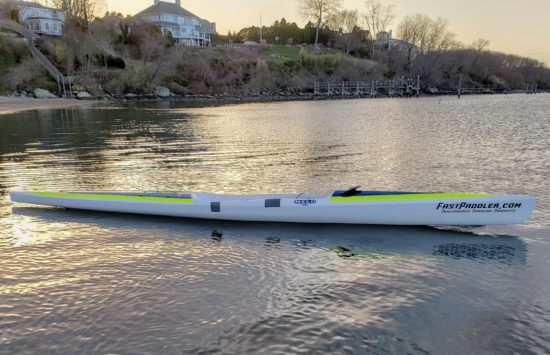
As you can see from the picture in the V racks below, the 540L is a low-volume ski with a “bump-out” or concavity in the hull at the footwell, which is a totally different design than any other ski on the market. The 540L also has a soft chine incorporated in a small section of its hull. The bow and stern are low volume with more rocker. Unlike other surfski brands, the Nelo’s come in different bucket sizes for the same model of ski with slight differences in overall volume between sizes. Brilliant!


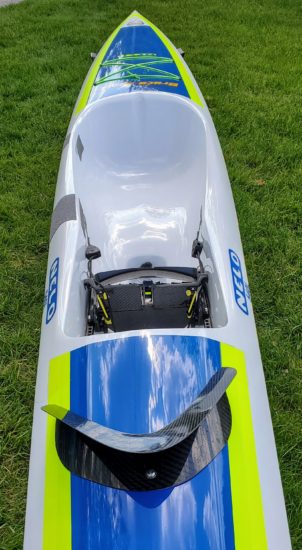
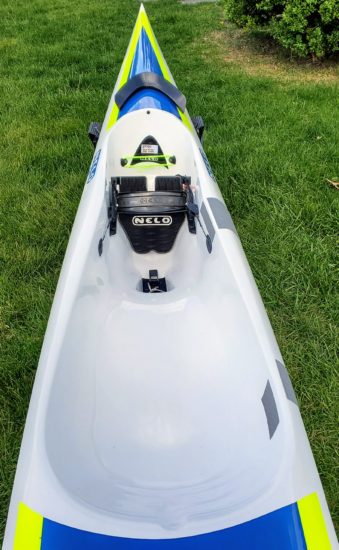
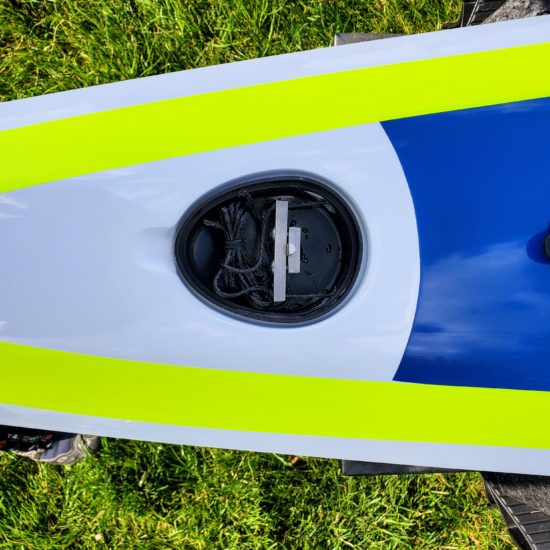
Nelo says this about its new design:
“Friction Reduction: The rocker increased on the stern, reduces the wet surface, and improves water flow on the stern. Hull with more grip on the water due to the high-pressure point on the concavity, which improves stability and direction. Improved maneuverability as the pivoting point of the boat has been moved forward. Improved stability due to lower center gravity by lowering the seat. “
So you can see from the design changes above, more stability is the theme while maximizing the glide for shorter boats. What we also know from the previous generation is that shorter skis have their advantages: easy to carry, store, and car top. Shorter skis are lighter with less material, turn quickly and accelerate easily. Lower volume skis have their attributes too. This has been the trend for all brands over the past several years offering less windage, weight savings, but often are wet rides, requiring a wave deflector and therefore more time is spent opening and closing the bailer.
So how does the 540L paddle?
My first paddle in the 540L was a ten-mile flat condition paddle on the Sakonnet where I live with Chris Chappell in his newly-designed 550. The Nelo comes standard with a 7-inch surfing rudder that I used for all my outings except for race I did (7 inch DK). What was immediately apparent is that the footplate railings are now long enough to accommodate short paddlers like me without a special order. If you have never been in a Nelo, the toe pedal adjusters are a rachet design that can be adjusted while the paddler is seated in the bucket, a very convenient for making minor adjustments. The Nelo’s need a wave deflector that in the past was taped on, but now they have one single screw that securely holds it in place. Like the past generation, a leash attachment point is provided too and they all have the DeBrito bailers. The footplate comes in two layups, carbon, and plastic. I like the carbon version.
Since the 540L straddles between the 520 and the 550, I expected it to be stable which it is. It is closer in stability to the 520 than the 550. The 520 is unbelievably stable. You practically have to will yourself to capsize in it. The 540L is similar in this regard so I think most novice paddlers would gain confidence early on. Once I got underway, the glide was appreciated along with the narrow catch. So while quite stable the 540L has a sporty feel to it and nice glide. Once I got warmed up, I was able to get into a nice groove of paddling hard with excellent leg drive and hip rotation due to the super comfortable bucket and the offset between the seat height and the footwell. While this is a large bucket in which I have some room on the sides of the cockpit, my butt is nicely planted squarely in the center of the cockpit with no slippage from side to side. I ordered my 550 and 560 with a large bucket. The hump is one of the lowest on the market so as to not to impede leg drive even for the short folks. As you move down, the cockpit tapers nicely to support your thighs without feeling cramped. The footwell is close fitting so your feet do not wander. So the ergonomics of the seating position is superb. I called this cockpit a semi-relaxed fit with an average depth. The back of the bucket is angled so you can lean back comfortably while surfing a wave or just stretch out on a long paddle. The gunwales are not too high so easy to spread your legs when in the resting position or remounting. Due to the depth and shape of the bucket a broad range of paddlers will fit comfortably. What I noticed too is that you feel very planted in the cockpit. So no matter what the rest of the ski is doing, you feel planted and centered. As Nelo stated, the ski does have a pivot point that you can feel when turning sharply. So with a great fit, stable platform, I was able to motor to Black Point in good form and continue for another seven miles. After the paddle, I told Chris that a lot of paddlers are going to enjoy this boat.
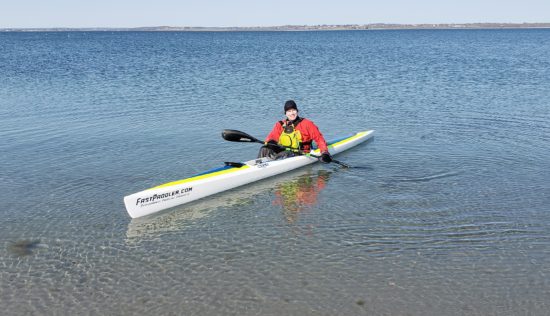
For my third paddle in the 540L, I wanted to test it in true ocean conditions vice small bay conditions of the Sakonnet so I headed to 3rd beach and paddled around Flint Ledge and halfway around Sachuest Point. Conditions here were 2 to 3-foot waves that move very quickly and are more complex and technical since the ocean water moves around to point. Going upwind, on the quarter beam the 540L was very stable and nicely predictable. Going downwind for the first loop, I was able to accelerate quickly onto the waves I wanted to catch. I did notice the front end moving some which reminded me of the previous generation. Then on the second downwind loop, I adjusted to the downwind feel. As I was finishing my paddle, I realized that my toe pedals were one click off from each other, therefore contributing to front-end movement. Experienced paddlers like myself can quickly adjust to the “feel” of skis which is what I did on the second loop. The lesson learned here is that there is more margin of error in stable skis vice the advanced skis. In advanced skis, uneven toe pedals is immediately noticed. As most of us know that have paddled more than one ski, they all have different “feel” that takes some time to get used to, so you know intuitively how the ski will react in varying conditions. So with all that said, I enjoyed the 540L in those conditions, confident, able to apply power with confidence, and not spend energy worrying about capsizing.
Remembering some past paddles in this area
I will digress slightly since I am remembering a few of my memorable paddles in this section of the ocean that I tested the 540L in. On a group paddle in 2004 in my S1X I capsized in 4ft seas, failing to remount. Mike McNulty, an extremely capable paddler, pulled up beside me, steadied my ski and I attempted another remount. That did not work, but on the second attempt with Mike’s help, I was able to remount. On another occasion, three of us were caught in a 40 mile per hour squall at our backs coming from 2nd beach back to 3rd beach. That is one of my scariest moments in a surf ski. I am thankful I had good skills and was in a stable ski at that time, the Huki S1R. The lesson learned here is that the bad weather came 3 hours earlier than predicted. So the forecast is not always correct, so plan accordingly if it shows up early. Also in rough conditions, you are on your own, so go over your safety checklist: communication devices, the leash of choice: paddle, leg, waist, pfd, stable ski, and know the take-out points. Also, look at a chart to determined the conditions you are most likely to encounter. The most important decision you will make is to leave the beach or not.
https://connect.garmin.com/modern/activity/6550832807
540L Speed, A pleasant surprise.
Time Trial on Sakonnet.
https://connect.garmin.com/modern/activity/6608144173
Above is the link to one of my time trials for the 540L. While I was working hard, I was pleased with the speed over the 2.33 mile averaging 7.3 miles per hour on a downwind leg with the tide. I also did several back-to-back intervals in the 540L and the Zen. Speeds were similar despite very different bucket shapes and hull designs.

When I can, I like to do a race in the ski that I am reviewing. I was able to race the 540 at the 2021 Battle of the Bay 6 mile, 2 loop course in Newport, Rhode Island on a very flat day. I was very well rested for the race and had a very good race averaging 155 heart rate and under pressure the whole race. I switched out the standard rudder to a 7 inch DK rudder. My time compared to my racing colleagues was better than I thought it would be. I typically do better in conditions vice flat but I was very pleased with my performance and once again the speed of the 540L. I did notice at one point, I was behind one of the racers by a few boat lengths and was able to get on the wave he was generating and the 540 was able to plane. I thought to myself, this is nice. So between my time trials and the race, the 540 exceeded my speed expectations.
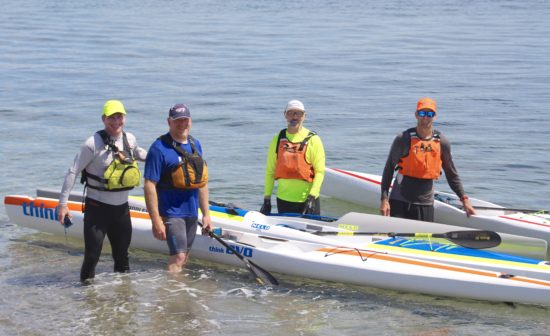
Below is the link to the Battle of the Bay Garmin info and Results
https://connect.garmin.com/modern/activity/6784215200
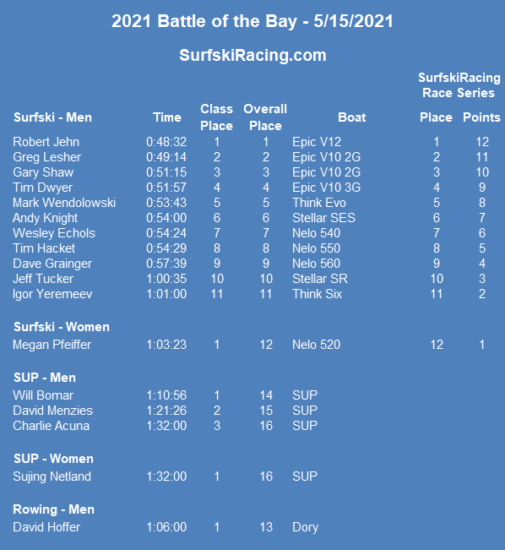
Aging Experience
I am like many paddlers across the globe in the 50-60 age group that can still be competitive. If you look at the race results, often this age class of paddlers is one of the largest groups. One of my qualifying questions for paddlers buying a ski is “how old are you?” since our balance diminishes over time for many of us. While many of us can still paddle advanced skis and intermediate skis in conditions, dropping down to a more stable ski can be more enjoyable, faster, and safer. So do not let your ego get in the way. Now, most of my ocean races are done in intermediate skis or even the “entry-level” vice my fastest years of surf ski racing in 2008-2018 when I could paddle advanced skis in any conditions. You can thank all the surf ski manufacturers for continuing to design surf skis for virtually every paddler, regardless of age, skill level, and size.
Pro and Cons
Pros: Superb ergonomic seating for a wide range of paddlers, Different size buckets for the same model. Easy and convenient to store, transport, maneuver, accelerate. Low volume skis less affected by wind. Stable skis are easier to remount. The same rudder can be used on different models. Very stable ski with better than expected speed and glide.
Cons: No side handles for 520 or 540(can buy kit or apply rubber non-skid tape for gripping)
My History with Nelo Surf Skis
This is Nelo’s third time at the surf ski rodeo and my third time reviewing Nelo surf skis too. In 2012 I reviewed Chris’ Chappell’s Nelo Vintage at 30lbs and I owned a 22lb Vintage in yellow and blue cobra stripes. These were comfortable, very fast skis, but very unstable due to the most forward bucket of any surf ski and a rounded hull along with a funky rudder. However, I clocked my fastest time EVER in a Nelo Vintage for my 1.62-time trial course averaging 8.4 mph with a time of 11:55 that I have done since 2003. I have come very close to that in some of my other skis over the years, but this odd ski below still holds the record.
Below are some pics of the Nelo skis I have owned/reviewed over the years.
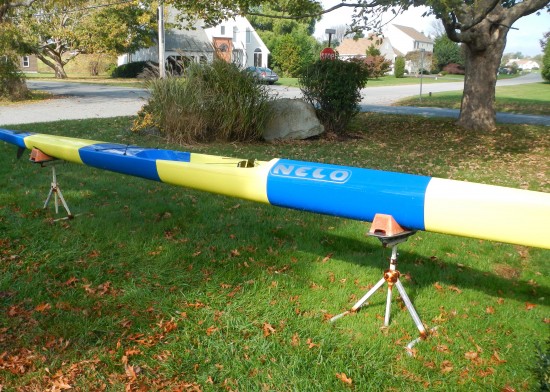
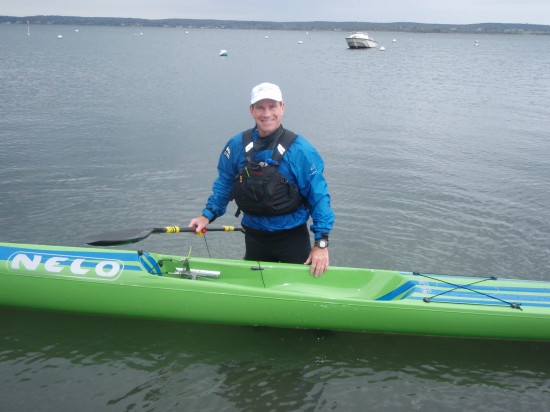

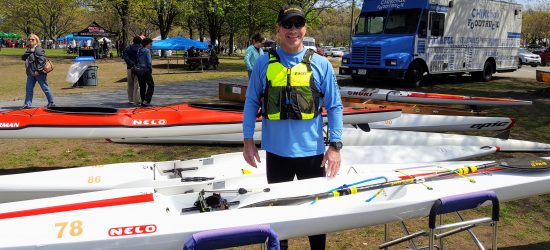
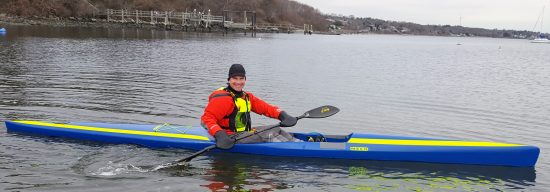
In summary I enjoyed paddling and racing the 540L. I was intrigued by the new design like many paddlers. This generation of Nelo built on the attributes of the previous generation while improving stability/glide and adding the 540 to the range of Nelo skis providing a ski for all skill levels and sizes of paddlers.
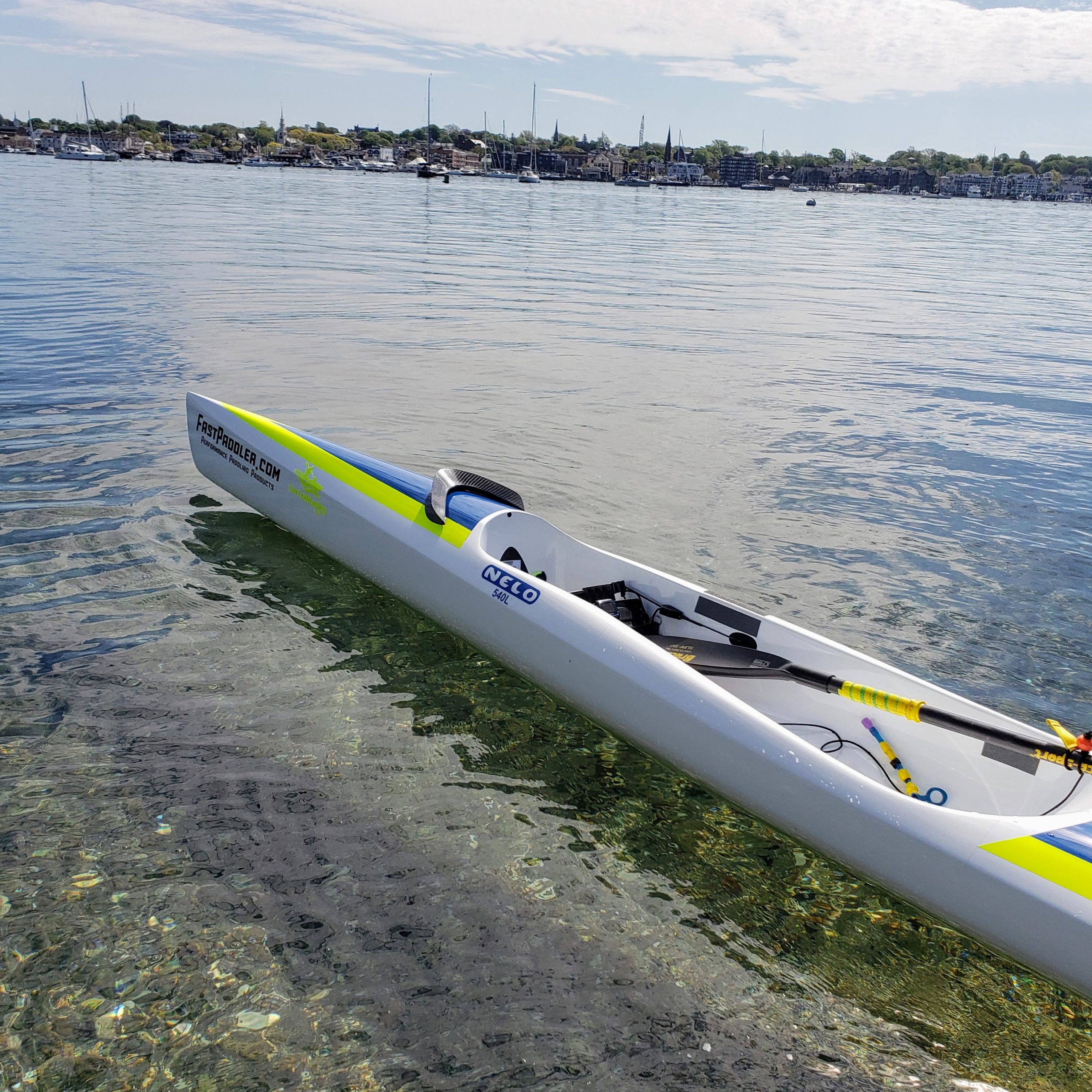
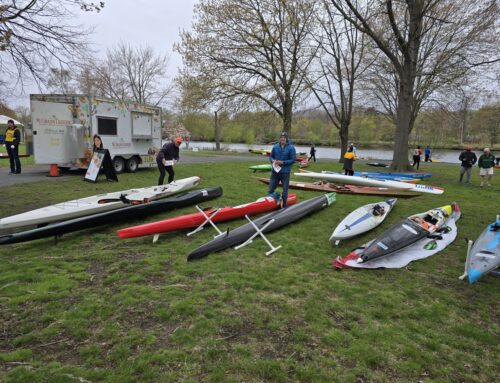
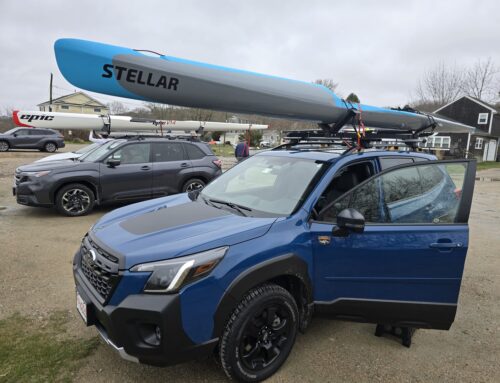
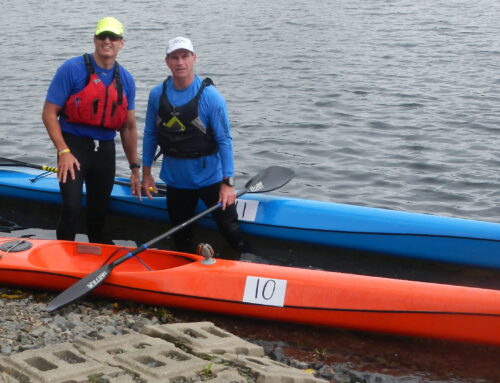
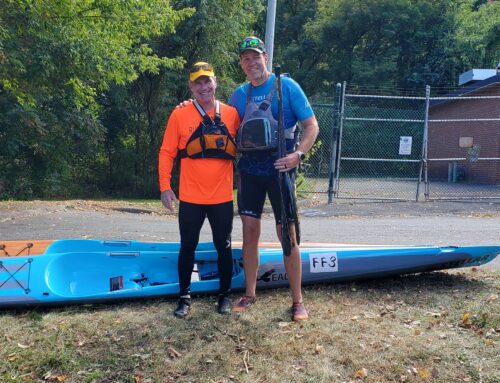
Leave A Comment
You must be logged in to post a comment.